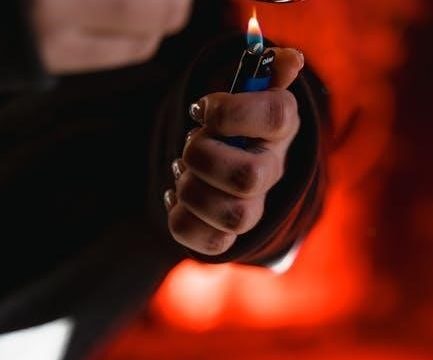The White Rodgers Gas Valve Manual provides comprehensive guidance for models like 36C03 and 36G22‚ covering installation‚ troubleshooting‚ and maintenance. It ensures safe and efficient operation.
1.1 Overview of White Rodgers Gas Valve Models
White Rodgers offers a variety of gas valve models‚ including the 36C03‚ 36G22‚ and 36G23‚ designed for different applications. These models feature single-stage‚ combination‚ and multi-function controls‚ combining gas cocks‚ regulators‚ and pilot systems. The 36C series includes redundant pilot solenoids and pressure switches‚ while the 36G series is known for its compact design and versatility. These valves are suitable for residential furnaces‚ pool heating‚ and commercial systems. Each model is engineered to regulate gas flow efficiently and ensure safe operation. Understanding the specific features of each model is crucial for proper installation and maintenance‚ as outlined in the manual.
1.2 Importance of Proper Installation and Maintenance
Proper installation and maintenance of White Rodgers gas valves are critical for ensuring safety‚ efficiency‚ and longevity. Incorrect installation can lead to gas leaks‚ ignition issues‚ or system malfunctions‚ posing serious risks. Regular maintenance‚ such as cleaning and inspecting components‚ helps prevent wear and tear. Adhering to the manual’s guidelines ensures compliance with safety standards and regulations. Neglecting maintenance can result in reduced performance‚ higher energy costs‚ and potential hazards. By following the recommended procedures‚ users can optimize their system’s operation‚ prevent costly repairs‚ and maintain a safe environment. Proper care extends the lifespan of the valve‚ ensuring reliable performance over time.
Installation Instructions for White Rodgers Gas Valves
This section provides a step-by-step guide for installing White Rodgers gas valves‚ ensuring safety‚ compliance‚ and proper functionality for models like 36C03 and 36G22;
2.1 Pre-Installation Requirements and Safety Precautions
Before installing a White Rodgers gas valve‚ ensure the gas supply is turned off and the electrical power is disconnected. Verify the valve is compatible with your system and properly rated for the application. Always follow local codes and regulations. Ensure the area is well-ventilated to prevent gas accumulation. Inspect the valve for any damage or defects before installation; Use only approved materials for connections to avoid leaks. Familiarize yourself with the manual and safety guidelines to prevent accidents. Proper orientation of the valve is crucial; it should not be installed upside down. Conduct a gas leak test after initial connections. Adhere to these precautions to ensure a safe and reliable installation process.
2.2 Connecting Main Gas Piping and Pilot Gas Connection
Connect the main gas piping to the valve’s inlet port‚ ensuring the pipe size matches the valve’s specifications. Use approved materials for gas connections to prevent leaks. For the pilot gas connection‚ attach a 1/4″ pilot line to the designated port‚ ensuring it is securely fitted. Avoid over-tightening to prevent damage. If the pilot outlet is plugged‚ remove the plug before connecting the pilot line. Ensure the pilot gas pressure is within the recommended range to avoid ignition issues. After connections‚ perform a gas leak test using a soap solution or leak detector. Properly seated connections are critical for safe and efficient operation. Follow the manual’s guidelines for specific model requirements‚ such as the 36C03 or 36G22 series.
2.3 Electrical Wiring and Connections
Connect the electrical wiring according to the wiring diagram in the manual. Ensure all connections are secure and match the valve’s terminal designations. For models like the 36C03‚ connect the mercury flame sensor to the designated terminal. Use appropriately rated wires and avoid crossing or pinching wires during installation. Power supply should meet the valve’s voltage requirements‚ typically 24V AC. After wiring‚ test the system to ensure proper function. Refer to the manual for specific instructions on connecting components like the ignition module or control board. Proper electrical connections are essential for safe and reliable operation of the gas valve. Always turn off the power supply before making or adjusting connections to prevent electrical hazards. Follow local electrical codes and regulations during installation.
2.4 Final Installation Checks and Tests
After completing the installation‚ perform a thorough inspection of all connections‚ including gas piping‚ electrical wiring‚ and pilot lines. Ensure there are no leaks by applying a soap solution to connections and checking for bubbles. Test electrical connections with a multimeter to confirm proper voltage and continuity. Ignite the pilot and verify a stable flame. Check the main burner ignition to ensure smooth operation. Refer to the wiring diagram to confirm all components are correctly connected. Test the valve under various operating conditions to ensure proper function. Document all test results and address any issues promptly. Follow safety guidelines and manufacturer recommendations for final system verification. This step ensures the gas valve operates safely and efficiently. Always double-check before finalizing the installation. Proper testing prevents future malfunctions and ensures reliability.
Operating the White Rodgers Gas Valve
Understand control functions‚ ignition settings‚ and monitoring features. Ensure proper operation by following manual guidelines for starting‚ shutting down‚ and adjusting the valve. Optimize heating efficiency and safety.

3.1 Understanding the Control Functions and Features
The White Rodgers gas valve features advanced control functions‚ including redundant pilot solenoids‚ main gas regulators‚ and pressure switches. These components ensure precise gas flow regulation and safe operation. The valve is designed for compatibility with both standing and continuous pilot systems‚ offering flexibility for various heating applications. Key features include automatic shut-off‚ electrical connections for flame sensors‚ and a compact design for easy installation. Understanding these functions is crucial for optimizing performance and troubleshooting. The control unit integrates multiple safety mechanisms‚ such as high pilot gas pressure monitoring‚ to prevent ignition issues. Familiarizing yourself with these features ensures efficient and reliable operation of your gas valve system.
3.2 Starting and Shutting Down the Gas Valve
Starting and shutting down the White Rodgers gas valve involves specific steps to ensure safety and efficiency. Begin by ensuring the gas supply is turned off and verifying there are no leaks. Once the system is ready‚ turn on the gas supply and activate the pilot light according to the manual. For models like the 36C03‚ ensure the redundant pilot solenoid is functioning correctly. When shutting down‚ turn off the thermostat and allow the system to cool before closing the main gas valve. Always follow the sequence outlined in the manual to prevent damage or hazards. Proper startup and shutdown procedures are essential for maintaining the valve’s performance and longevity.
3.3 Monitoring Gas Valve Performance
Monitoring the performance of your White Rodgers gas valve is crucial for ensuring safe and efficient operation. Regularly check the pilot light to confirm it remains lit and stable. For models like the 36C03‚ ensure the redundant pilot solenoid is functioning correctly. Inspect gas pressure levels to avoid sputtering or flame lift-off issues. Listen for unusual noises‚ which may indicate worn parts or improper installation. Check electrical connections for tightness and integrity. Refer to the manual for specific error codes and alarms‚ as these can signal potential problems. Always follow the recommended maintenance schedule to ensure optimal performance and safety. Regular monitoring helps prevent malfunctions and extends the valve’s lifespan.

Troubleshooting Common Issues
Troubleshooting your White Rodgers gas valve involves identifying issues like ignition problems‚ gas leaks‚ or electrical faults. Use error codes and wiring diagrams to diagnose and resolve issues effectively.
4.1 Diagnosing Ignition Problems
Diagnosing ignition issues in White Rodgers gas valves involves checking the pilot gas pressure‚ solenoid operation‚ and spark generation. High pilot gas pressure can cause sputtering or poor ignition. Ensure the pilot line is clear and properly connected. If the pilot fails to light‚ inspect the solenoid for faults or blockages. Verify electrical connections to the ignition electrode and spark generator. Consult the manual for specific error codes related to ignition failure. Always turn off the gas supply before performing detailed inspections. Proper troubleshooting ensures safe and reliable operation of the gas valve system.
4.2 Addressing Gas Leaks and Pressure Issues
Gas leaks and pressure issues with White Rodgers valves require immediate attention. Start by turning off the gas supply and inspecting connections for tightness. Use a soap solution to detect leaks around fittings. If a leak is found‚ replace the faulty gasket or seal. For pressure issues‚ check the regulator settings and ensure they match the specified range. High pilot gas pressure can cause ignition problems‚ so adjust the regulator as needed. Always refer to the manual for specific pressure recommendations. If issues persist‚ consult a professional to avoid safety hazards. Properly addressing these problems ensures reliable operation and prevents potential dangers.
4.3 Solving Electrical and Wiring Problems
Electrical issues with White Rodgers gas valves often stem from loose connections or faulty wiring. Start by verifying all connections are secure and meet the manual’s specifications. Use a multimeter to check for short circuits or open wires in the system. If the valve fails to respond‚ ensure the power supply is stable and switches are functioning correctly. For models like 36C03‚ check the electrical connections to the solenoid and pilot sensor. Consult the wiring diagram to trace and resolve issues. Common problems include miswired terminals or damaged cables. Always turn off the power before performing repairs. If issues persist‚ refer to the troubleshooting section or contact a certified technician for assistance.
4.4 Understanding Error Codes and Alarms
White Rodgers gas valves are equipped with error codes and alarms to indicate specific issues. These codes‚ displayed on the control unit‚ help diagnose problems quickly. For instance‚ codes like “E1” or “E2” may signal ignition failures or gas pressure issues. Refer to the manual for a detailed list of codes and their meanings. Alarms often sound when safety thresholds are breached‚ such as excessive gas flow or temperature limits. Addressing these issues promptly is crucial for safety and efficiency; Always consult the troubleshooting section or contact a professional if unresolved. Regular maintenance can prevent many of these errors‚ ensuring reliable operation of your gas valve system.

Maintenance and Upkeep of the Gas Valve
Regular maintenance ensures optimal performance and safety. Clean the valve‚ inspect for wear‚ and replace damaged parts promptly. Follow manual guidelines for best practices and reliability.
5.1 Routine Cleaning and Inspection
Regular cleaning and inspection are crucial for maintaining the efficiency and safety of your White Rodgers gas valve. Start by turning off the gas supply and power to the system. Use a soft brush or cloth to remove dirt‚ dust‚ or debris from the valve’s exterior and internal components. Pay special attention to the pilot area‚ as blockages can disrupt ignition. Inspect all connections‚ seals‚ and wires for signs of wear or damage. Check the solenoid valves and pressure regulator for proper function. Replace any worn or corroded parts immediately to prevent leaks or malfunctions. A well-maintained valve ensures reliable performance and reduces the risk of safety hazards.
5.2 Replacing Worn or Damaged Parts
Replacing worn or damaged parts in your White Rodgers gas valve is essential for maintaining its performance and safety. Always turn off the gas supply and power before starting any replacement. Identify the faulty component‚ such as a solenoid valve‚ diaphragm‚ or seal‚ and ensure you have the correct replacement part. Use genuine White Rodgers parts to guarantee compatibility and reliability. Disconnect electrical connections and gas lines carefully‚ then remove the damaged part. Install the new component according to the manual’s instructions‚ ensuring all connections are secure. After replacement‚ test the valve to confirm proper function. Regular part replacement prevents malfunctions and ensures long-term efficiency and safety.
5.3 Best Practices for Long-Term Reliability
For long-term reliability‚ adhere to routine maintenance and inspection schedules outlined in the White Rodgers gas valve manual. Regularly clean the valve and its components to prevent debris buildup. Inspect pilot lines and electrical connections for wear or damage‚ ensuring they are secure and functioning properly. Use only genuine White Rodgers replacement parts to maintain performance and safety. Schedule annual professional inspections to identify potential issues before they escalate. Properly store spare parts and follow the manual’s guidelines for troubleshooting and repairs. Consistent maintenance ensures optimal gas flow‚ efficient operation‚ and extends the lifespan of your White Rodgers gas valve‚ minimizing the risk of unexpected failures.

Wiring Diagrams for White Rodgers Gas Valves
Wiring diagrams for White Rodgers gas valves provide clear visual guides for connecting components‚ ensuring proper installation and troubleshooting. They detail electrical connections and component interactions.
6.1 Understanding the Wiring Diagram Layout
The wiring diagram for White Rodgers gas valves is a visual representation of electrical connections and components. It includes symbols for wires‚ terminals‚ and devices‚ with color coding for clarity. The layout typically starts with the control unit‚ showing connections to sensors‚ solenoids‚ and ignition systems. Each wire’s purpose is indicated‚ such as power supply‚ signal‚ or ground. The diagram also highlights safety features like flame sensors and pressure switches. Understanding the layout is crucial for proper installation‚ troubleshooting‚ and ensuring all components function together seamlessly. Referencing the diagram helps technicians identify potential issues and verify connections‚ ensuring safe and efficient operation of the gas valve system.
6.2 Connecting Components According to the Diagram

Connecting components as per the wiring diagram ensures proper functionality and safety. Start by identifying the control unit‚ solenoids‚ and pilot line connections. Match wire colors to their designated functions‚ such as power‚ signal‚ or ground. Connect the main gas valve solenoid to the control unit‚ ensuring secure terminals. Pilot lines should be linked to the ignition system‚ while flame sensors attach to their respective ports. Verify all connections align with the diagram to avoid mismatches. Double-check for loose wires and ensure proper grounding. Incorrect connections can lead to gas leaks or ignition failures. Follow the diagram meticulously to guarantee safe and efficient operation of the White Rodgers gas valve system.
6.3 Troubleshooting Using the Wiring Diagram
Troubleshooting with the wiring diagram helps identify issues quickly. Start by comparing the physical setup with the diagram to ensure all connections match. Check for loose wires‚ incorrect connections‚ or damaged cables. If the gas valve fails to activate‚ verify the solenoid wiring and power supply. For ignition problems‚ inspect the pilot line and flame sensor connections; Use the diagram to trace signal paths and ensure proper grounding. If error codes appear‚ refer to the wiring diagram to isolate faulty components. Correcting mismatches or faults as per the diagram restores functionality. This methodical approach minimizes downtime and ensures safe‚ efficient operation of the White Rodgers gas valve system.
Safety Guidelines and Precautions
Adhere to safety guidelines to prevent accidents. Properly handle gas leaks and emergencies. Ensure compliance with local and national regulations for safe installation and operation;

7.1 General Safety Tips for Gas Valve Installation
Ensure the gas supply is turned off before starting installation. Disconnect electrical power to avoid shocks. Use proper tools to prevent damage. Ventilate the area to avoid gas accumulation. Follow manufacturer instructions precisely. Be aware of local safety codes and regulations. Never smoke or have open flames nearby. Ensure all connections are tight to prevent leaks. Use a gas detector to verify safety. Keep emergency contact numbers handy. Always test the system after installation. Proper safety measures ensure a secure and reliable gas valve operation‚ protecting both people and property from potential hazards.
7.2 Handling Gas Leaks and Emergencies
In case of a gas leak‚ immediately turn off the main gas supply and open windows for ventilation. Do not ignite flames or sparks. Evacuate the area and contact a qualified technician or emergency services. Use a gas detector to confirm the leak source. Never attempt repairs without proper training. If a valve fails‚ shut off the gas supply and disconnect electrical power. Keep emergency contact numbers accessible. Always follow the manufacturer’s emergency procedures. Regular inspections can help prevent leaks. Remember‚ gas leaks are critical situations requiring immediate attention to ensure safety and prevent potential disasters. Stay calm and act swiftly to minimize risks.
7.3 Compliance with Local and National Regulations
Ensure all installations and operations of White Rodgers gas valves comply with local and national safety regulations. Obtain necessary permits and follow installation codes. Regularly inspect systems to meet certification standards. Non-compliance can result in legal penalties and safety risks. Familiarize yourself with regional gas safety laws and update your system accordingly. White Rodgers provides resources to help users understand regulatory requirements. Always prioritize compliance to ensure safe and legal operation of your gas valve system. This not only avoids penalties but also guarantees the safety and efficiency of your heating system. Stay informed about updates to regulations and adapt your practices as needed.
Technical Specifications of White Rodgers Gas Valves
White Rodgers gas valves offer advanced features like redundant solenoids‚ pressure regulators‚ and compact designs. Models like 36C03 and 36G22 are designed for versatility and efficiency.
8.1 Gas Valve Models and Their Applications
White Rodgers offers various gas valve models‚ each designed for specific applications. The 36C03 and 36G22 models are popular for residential furnaces‚ pool heating‚ and commercial systems. The 36C series is ideal for standing or continuous pilot systems‚ while the 36G series suits single-stage ignition applications. These valves are compatible with Spark or Hot Surface Ignition systems‚ making them versatile for different heating setups. They are also used in rooftop heating‚ laundry‚ and cooking equipment‚ showcasing their adaptability; With features like redundant solenoids and pressure regulators‚ these models ensure reliable performance across diverse installations‚ catering to both residential and commercial needs effectively.
8.2 Pipe Sizes and Gas Capacity Specifications
White Rodgers gas valves are designed to accommodate various pipe sizes and gas flow requirements. Models like the 36C03 and 36G22 support standard pipe sizes‚ ensuring compatibility with most heating systems. The gas capacity specifications vary by model‚ with the 36C series offering robust flow rates for high-demand applications. Proper pipe sizing is crucial to maintain optimal gas pressure and efficiency. The valves are engineered to handle natural gas and propane‚ with clear guidelines provided in the manual for safe installation. Adhering to these specifications ensures reliable performance and compliance with safety standards‚ making White Rodgers gas valves a versatile choice for diverse heating needs.
8.3 Compatibility with Different Heating Systems
White Rodgers gas valves are designed to integrate seamlessly with a variety of heating systems‚ ensuring versatility and reliability. Models like the 36C03 and 36G22 are compatible with residential furnaces‚ pool heaters‚ and commercial rooftop units. They also support both direct spark ignition (DSI) and hot surface ignition (HSI) systems‚ making them adaptable to different configurations. The valves are suitable for natural gas and propane applications‚ further enhancing their compatibility. This flexibility allows White Rodgers gas valves to meet the demands of diverse heating systems‚ ensuring efficient and safe operation across multiple environments. Their universal design makes them a preferred choice for both residential and commercial installations.
The White Rodgers Gas Valve Manual is an essential guide for safe and efficient operation. It provides detailed instructions for installation‚ maintenance‚ and troubleshooting‚ ensuring optimal performance and longevity of the valve.
9.1 Summary of Key Points
The White Rodgers Gas Valve Manual is a comprehensive guide covering installation‚ operation‚ and maintenance of various models like 36C03 and 36G22. It emphasizes safety‚ proper wiring‚ and regular inspections to ensure optimal performance. The manual provides detailed troubleshooting steps for common issues‚ such as ignition problems and gas leaks‚ and offers best practices for long-term reliability. By following the manual‚ users can maintain compliance with local regulations and extend the lifespan of their gas valves. This resource is indispensable for technicians and homeowners seeking to understand and manage their White Rodgers gas valve systems effectively.
9.2 Importance of Following the Manual
Adhering to the White Rodgers Gas Valve Manual is crucial for ensuring safety‚ efficiency‚ and compliance with regulations. Proper installation and maintenance procedures prevent gas leaks and ignition issues‚ while troubleshooting guides help resolve problems quickly. The manual’s specifications for models like 36C03 and 36G22 ensure compatibility and optimal performance. Ignoring the manual can lead to safety hazards‚ system malfunctions‚ and non-compliance with local codes. By following the guidelines‚ users can extend the lifespan of their gas valves and maintain reliable operation. Compliance with the manual’s instructions is essential for protecting both people and property while ensuring the system functions as intended.

Additional Resources and Support
Access the full White Rodgers Gas Valve Manual online for detailed instructions. Contact customer support for direct assistance‚ and explore online forums for community-driven troubleshooting and updates.
10.1 Accessing the Full White Rodgers Gas Valve Manual

To access the full White Rodgers Gas Valve Manual‚ visit the official White Rodgers website or authorized distributors. The manual is available for models like 36C03 and 36G22‚ providing detailed installation‚ troubleshooting‚ and maintenance instructions. It includes technical specifications‚ wiring diagrams‚ and safety guidelines to ensure proper use. The manual is designed to be user-friendly‚ catering to both professionals and DIY enthusiasts. Download the PDF version for easy reference‚ compatible with all devices. Ensure to use the official manual for accurate information‚ as third-party sources may lack authenticity. Additional resources like troubleshooting guides and maintenance tips are also included for comprehensive support.
10.2 Contacting Customer Support for Assistance
For assistance with White Rodgers gas valves‚ contact their customer support team directly. Visit the official White Rodgers website to find contact details‚ including phone numbers‚ email addresses‚ and live chat options. The support team is available to address installation‚ troubleshooting‚ and maintenance inquiries. They can also provide clarification on technical specifications and error codes. Additionally‚ customer support can guide you through complex procedures‚ such as wiring or replacing parts. Ensure to have your gas valve model number (e.g.‚ 36C03 or 36G22) ready for faster assistance. White Rodgers customer support is known for its reliability and expertise‚ making it a valuable resource for resolving issues efficiently.
10.3 Online Communities and Forums for Troubleshooting
Online communities and forums are invaluable resources for troubleshooting White Rodgers gas valve issues. Platforms like HVAC forums‚ Reddit‚ and specialized trade communities offer peer-to-peer support. Users can share experiences‚ ask questions‚ and receive real-time advice from experienced technicians and DIY enthusiasts. These forums often include discussions on common problems‚ such as ignition issues or gas leaks‚ and provide step-by-step solutions. Many threads reference specific models like the 36C03 or 36G22‚ making it easier to find relevant information. While these communities are helpful‚ always cross-reference solutions with the official White Rodgers manual or contact customer support for critical issues to ensure safety and compliance with manufacturer guidelines.







